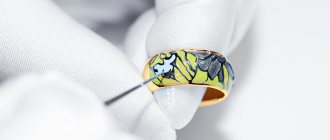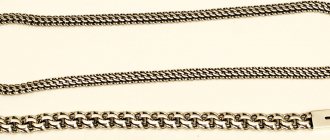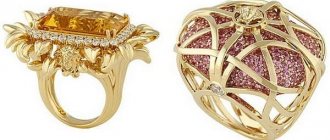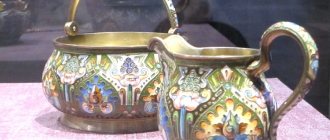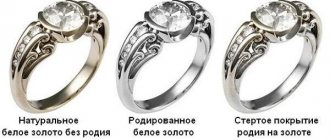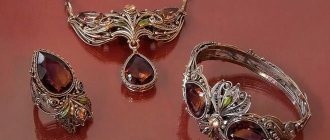If you want to be the owner of a unique piece of jewelry, buy jewelry with colored enamel. After all, even with relatively “mass” production, jewelry coated with enamel is rather handmade. The resulting products are always slightly different from each other, so no one will have exactly the same one.
In professional language, enameling is the application of fusible glass to a metal surface (more about the technology of hot and cold enamels). Jewelry made on a metal base is also coated with colored enamels. Enamels differ in composition and method of application to the surface. Cloisonne, fissure, champlevé (armor) are different ways of achieving one goal: fixing hot enamel to metal. The name of each method reveals the essence and speaks for itself.
Colored enamel on jewelry: application methods
Cloisonné enamel is named after gold or silver partitions. They are soldered onto the surface of the jewelry (gold or silver) according to the intended ornament. It was in these cells that the enamel powder melted at a temperature of 600-800 degrees, turning into glass. This type of enameling has a variety based on the “filigree” (filigree) jewelry technique, where instead of metal ribbon partitions there is a filigree thread soldered to the surface of the jewelry.
In an ornament with champlevé enamel (“champlevé”), the metal is “taken out” with a chisel, filling the recesses with the enamel composition. The champlevé enamel technique is the oldest and easiest to produce.
The technique of painted enamel (or enamel) is painting with colored enamel. There are no partitions or recesses in this technique. The enamel is applied to the item in layers and fired until the plot planned by the jewelry designer is completed. Frey Wille works , although the products of the Rostov enamel industry are better known by the term “enamel”.
By composition, jewelry with enamels can be transparent or translucent
and, in jewelry jargon,
“deaf” (opaque).
What is jewelry enamel?
What is jewelry enamel?
Jewelry enamel is a thin layer of fusible glass alloy. This jewelry material comes in various colors and shades. The enamel is applied to the metal surface in a powdery state, after which the product is placed in an oven and kept at a temperature of 700-800 degrees for 20-30 minutes. Then the product cools down and is sent to jewelry stores.
This material is not only intended for decorating jewelry, it also has anti-corrosion and protective properties. Enamel helps products resist atmospheric influences, as well as the influence of chemical reagents (acids, gases and alkalis).
Having this property, enamel also used in architectural structures that work on the exterior. An example of this use is copper tiles that cover the domes of churches and temples.
Jewelry enamel consists of a solid, glassy solution of silica, alumina and various other oxides. These oxides are also called fluxes. Fluids of potassium, lead and sodium increase the ease of melting of enamel , but the disadvantage of these oxides is a decrease in the resistance of the material to external factors.
And fluxes of aluminum, magnesium and silicon act in the opposite way. They make the enamel refractory and durable. To give enamels different colors, pigments are added; they are oxides of metals such as cobalt, nickel, lead, etc.
Jewelers of antiquity produced enamel on their own, however, from the 17th century this material began to be purchased from European countries, it was of higher quality, and the range of colors was more diverse.
Nowadays, jewelers and artists have begun to use enamel again and the interest in making this material on their own has grown greatly, since the technical difficulties that were present before do not exist now. Craftsmen who use enamel try to mix different color shades and fuse it for their work.
Types of enamel
There are transparent or through enamels, which are used to cover products made of gold and silver. Enamel adds color and shine to engraved or smooth areas of products and protects them from damage during use. Jewelry coated with transparent enamel ; it shimmers and plays in the rays of light.
There are also opaque or blind enamels . They are opaque and therefore are usually used on copper, but use on other metals is also allowed. Solid enamels have very bright and saturated colors, this is their main decorative advantage. In this respect they are superior to through enamels .
Jewelry enamel is ordinary fusible glass. The temperature at which this material melts is lower than the temperature at which the metal not only does not melt, but does not even soften or deform.
As a rule, in order to obtain colored transparent or dull opaque enamels , first of all, a base alloy called flux is prepared, after which dyes of different color shades are mixed into this colorless alloy and the resulting mass is melted again.
What metals are used for jewelry enamel?
Since ancient times, metals such as gold, silver, pure copper or its alloys have been coated with enamel, and sometimes bronze has been coated, and in the mid-19th century they began to coat cast iron and steel.
The main parameter of a metal when covering it with enamel is the temperature of its melting, softening and deformation. It must exceed 800 degrees, since the enamel melts at this temperature.
The ability of metals to maintain their luster and color fastness is also taken into account. It is usually possessed by precious stones - platinum, silver and gold. When fired, no oxide films appear on their surface, and the shine is well preserved under a layer of transparent enamel .
All other metals are usually coated with dull enamels, since when heated they become dull, quickly oxidize and darken. But if the product model requires a transparent area, then these places are covered with silver or gold foil, then the shine and lightness of the metal is preserved. Blue, green and blue colors of enamels glow magnificently on silver foil.
A very important point when coating metal with jewelry enamel is the thermal coefficient, which shows the linear expansion of the metal when it is heated and further cooled. The cleavage of these two components depends on this parameter.
It is also worth noting that the enamel will stick worse on a smooth surface than on a rough one. The coefficients of metal and enamel must match, otherwise, when cooling, the enamel will quickly peel off, then the whole difficult process will have to be carried out again, having first corrected all the errors.
Among the huge number of technical methods for processing precious metals, enamel coating has occupied a special place and is considered the pinnacle in applied art. Products coated with enamel look original, beautiful and exclusive. She helps master jewelers and artists realize their most unusual fantasies and ideas.
Jewelry with enamel according to the method of fixing the enamels
Colored enamels on jewelry are divided into hot
and
cold.
Hot enamels for jewelry
Hot enamel is an absolute favorite. It was used back in the old days. What is the hot enamel technique? In special muffle furnaces, the jewelry is heated to 600-800 degrees. The enamel is firmly baked to the metal. The jewelry is cooled, cleaned and polished. And today, the presence of hot enamel in the decoration of jewelry elevates jewelry to the highest level (just look at the prices of products from the 3R jewelry factory).
Women love enamel jewelry. Among the enamel crafts, we know Rostov enamel, the so-called picturesque
(hot) enamel.
minakari
jewelry variegated cloisonne enamel, generously sprinkled with stones and pearls.
Cold enamels for jewelry
Cold enamel is essentially fiberglass. It can be two-component, heat-curing and light-curing.
Two-component
cold enamel is mixed in the required proportion and poured onto the product.
Everything is as simple as a nail salon. Heat-curing
cold enamel is similar to hot enamel, but it melts at only 160 degrees. Any housewife will beat the shackles into bracelets in her kitchen. True, this enamel does not allow polishing - matte marks remain. The disadvantage of heat-curing enamel is its low strength. If desired, it can be pierced with a fingernail.
Light-curing
cold enamel is similar in properties to light-based dental fillings.
The composition applied to the surface is irradiated with an ultraviolet lamp, which causes the enamel to harden. In terms of hardness, this enamel is somewhere between hot and cold heat-curing enamels. It is with these enamels that chips are restored.
Read more about the cold enamel technique.
Jewelry with enamel: recommendations for buyers
In essence, enamel is glass. It is polished, cleaned, and is quite chemically resistant. However, chipping is inevitable when actively wearing jewelry with hot or cold enamel. The jeweler can “seal” the chip if the jewelry is memorable and expensive to you. You should wear enamel on jewelry (rings are especially at risk!) carefully, without banging your hands on the table or dropping the jewelry on hard surfaces (which happens when the jewelry is too big for you or the clasp is faulty). Now the Arabs’ craving for soft and lush carpets is understandable.
Use of enamel in jewelry
Enamel is good because it allows you to expand the color range of jewelry. In addition, with its help you can create the most complex, whimsical and fantasy designs. If the possibilities of using precious and semi-precious stones are somewhat limited, then enamel gives jewelers unlimited possibilities: a variety of shades and unusual designs.
The material is based on silica and alumina powder, which melts easily. By adding various oxides, craftsmen obtain powder of different properties and colors. For example, iron oxide gives a brownish tint, cadmium - red, cobalt - blue and black, copper - green. These colors are more saturated, bright and dense than the shades of other coatings used in jewelry.
There are several types of material. The first includes transparent enamel , which has no color. It is used for application to gold, silver and platinum, which enhances the shine of the metal, protects it from damage and tarnishing, and makes the color more durable.
The colored variety has a large color palette of rich shades. It also protects the decoration, prevents damage, oxidation, darkening, and allows craftsmen to realize original ideas.
Thus, gold rings with enamel offer not only a variety of designs and complex execution techniques, but also accessories that retain their appearance and brightness for a long time.
Complex technology
It would seem that enamel is not a precious crystal or even a rare semi-precious one. So why are accessories made using this technique sometimes more expensive than products with gems?
The fact is that the technology for using this powder is complex. This includes firing at a certain temperature, the correct selection of the type of powder, and the application of a coating so that warping and deformation do not occur. This requires highly qualified craftsman. The use of the powder is based on ancient jewelry craftsmanship - painstaking, and therefore it is valued accordingly.
